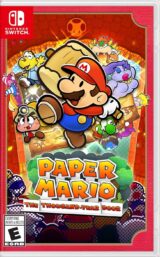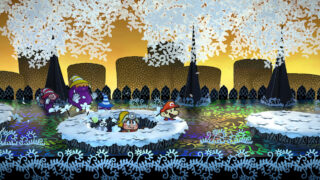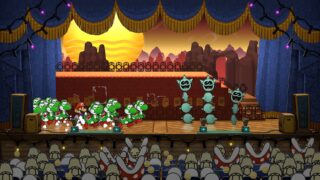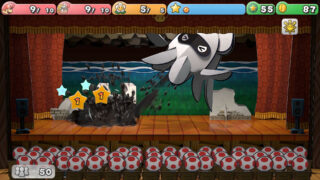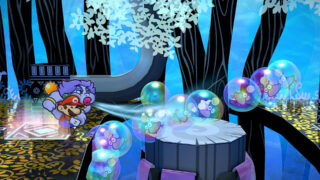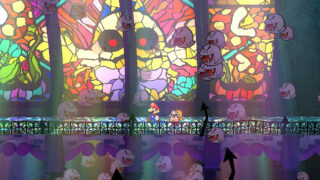Paper Mario: Thousand-Year Door remains a treasure, 20 years on
Nintendo’s consistently inventive and entertaining RPG stands up brilliantly on Nintendo Switch
- Chief director (original)
- Ryota Kawade
- Key Credits
- Chie Kawabe (Art director (original)), Misao Fukuda (Script)

20 years after its original release, Paper Mario: The Thousand-Year Door remains a treasure. With a refreshingly un-Mario-like script, a memorable and lovable cast, engaging turn-based gameplay, and more variety than your average Taylor Swift concert, the GameCube title is regarded by many as a classic entry in the plumber’s RPG lineage.
It’s no surprise then that it feels right at home on Nintendo Switch via this remake. While some of its level designs have aged somewhat, a significant visual glow-up and smart quality-of-life improvements ensure that it’s otherwise a robustly modern experience, and an easy recommendation to new and old fans as arguably the definitive Mario RPG.
Just like last year’s similarly excellent SNES remake, Thousand-Year Door marries traditional, turn-based RPG features with a comedic script and colouful cast of characters you really wouldn’t expect to see in a modern Mario game – partly due to franchise branding decisions we explained in detail in our earlier preview.
It’s a wonderfully weird – and often surprisingly dark – adventure, cushioned by the comfortingly familiar mechanics of a turn-based battler. Mario is once again out to rescue Princess Peach and discover magical Stars, but that’s where the similarity to his previous adventures ends.
The game’s opening area, which is a seedy town bustling with thieving goombas, criminal Piantas, and a literal hangman’s noose as its centrepiece, immediately sets the tone for the twisted, tongue-in-cheek satire to come. Just here, you’ll help a gangster boss capture his runaway daughter – who begs Mario to let her escape – and deliver an old sea pilot his deceased lover’s final message, in between hearing about an NPC’s stolen credit card or views on climate change. The Super Mario Bros. Movie, this isn’t.
What follows is a 30-hour adventure of consistently surprising and amusing scenarios, with Mario becoming an unlikely wrestling star, cursed ghost, pirate captain, and more in his quest to find the Crystal Stars. Interwoven are even more absurd and fun plots featuring (playable) Bowser and Princess Peach, the latter of whom arguably has her best role in any game to date as the captured romance target of a sentient computer. This is right up there with Nintendo‘s funniest ever adventures.
Powering the adventure is arguably the most unique cast of characters in any Mario game, which includes Goombella, the archaeology student Goomba with sarcastic quips; Koops, the timid Koopa Troopa out to impress his girlfriend; and Madame Flurrie, the eccentric wind spirit and former acting star, who can’t stop smooching our hero. Even the big baddies of the plot, an evil organisation known as X-Nauts, are entirely new to the Mushroom Kingdom.
Each companion introduces their own abilities and unique flavour to the script, to the point where meeting a new cast member feels like a power up by itself. Koops, for example, will give you the ability to fire his shell when exploring, to grab out-of-reach items. Meanwhile, Flurrie will allow you to blow away specific pieces of scenery, unlocking new paths.
During your quest, Mario himself will also level up with new abilities too, gifted by demonic treasure chests who amusingly ‘curse’ him. These include the ability to transform into a paper plane of boat, unlocking new means of exploration which encourage you to revisit old areas and discover secrets.
Like most Paper Mario games, the narrative is the star here. But where other entries have been let down by their occasionally gimmicky gameplay, Thousand-Year Door’s RPG mechanics remain pleasingly robust and consistently engaging, with players able to battle foes alongside their companions in turn-based battles, and level up their stats upon defeating enough of them.
“Where other entries have been let down by their occasionally gimmicky gameplay, Thousand-Year Doors RPG mechanics remain robust and consistently engaging”
At the time, these systems will have felt staunchly conservative. There’s little here that didn’t feature in the first two Mario RPG games, or indeed a decade of genre classics released before it. But after enduring dozens of tedious Paper Mario reinventions in the years since, it is frankly something of a relief to return to a set of balanced and compelling mechanics, with no stickers, cards, or bags of confetti in sight.
Key to TTYD’s combat is the tactical depth offered by the numerous equipable Badges, which add unique modifiers such as more powerful moves and abilities, and the constant introduction of companion characters, who ensure a consistent variety and welcome injection of interactivity, with each co-op partner adding a different mechanic, such as button mashing, timed presses or moving a target on the UI.
There’s also a twist within the environments of the battles: encounters take place on a stage in front of an audience of Mario NPCs, with more joining to watch as you perform crucial attacks or well-timed button presses to make moves stronger – a feature that’s appeared in other Mario RPG games.

Occasionally, moves will knock down scenery and damage opponents, or members of the audience will stand to throw protesting projectiles at Mario, which can be blocked with another well-timed button press. It’s a cute touch, even if it doesn’t happen all that often.
The biggest improvement in the Nintendo Switch version of the Thousand-Year Door, as you can see in our footage embedded above, are its delightful visuals and wonderful soundtrack.
Graphically, there really is little hint that this is a remake of a 20-year-old game, and to our eyes, it’s the best-looking Paper Mario to date. Here, the game’s developer gleans all the polish from the HD games released since, to make TTYD’s environments tangibly delightful, like papercraft dioramas that unfold as you explore them.
The lighting improvements alone make this a significant upgrade on the original game, making its darker areas even moodier, and giving the brighter environments a vibrant glow. Sadly, the Switch version does run at 30fps (compared to the original’s 60), but for this genre of game, that really shouldn’t matter, and it certainly didn’t bother us – especially considering how lovely it looks otherwise.
“Graphically, there really is little hint that this is a remake of a 20-year-old game, and to our eyes, it’s the best-looking Paper Mario to date.”
One area of TTYD that has aged is its frequent use of backtracking in its level designs. During the GameCube era, Nintendo seemed to have an obsession with artificially extending the length of its games – allegedly based on the view that it needed to release games more quickly – like Wind Waker’s Tri-Force Hunt or Metroid Prime’s hidden Artifacts.
In a similar spirit to those infamous fetch quests, Thousand-Year Door often tasks players with backtracking through the same environments – occasionally multiple times. Thankfully, this tedium is alleviated in the remake via multiple improvements, including the streamlining of some fast-travel options in the main hub.
There’s also the welcome addition of a new Partner Hint button, which tells players where to go next when you’re lost, a fast-swap menu, which makes changing between abilities needed to progress far less frustrating, and an NPC who will offer hints for how to complete side quests.
There are more additions in the Switch version, which we won’t share for spoiler reasons, which make revisiting it in 2024 even more compelling for those who remember and love the original, who can now experience it in – frame rate aside – its most definitive version.
For everyone else, Thousand-Year Door is an adventure that remains as memorable and captivating as any of Mario’s many spin-offs to date. It’s a consistently inventive and entertaining adventure that stands up brilliantly on Nintendo Switch, and feels genuinely unique among the mascot’s library. We’re grateful for the opportunity to experience it again.
Alongside last year’s excellent Super Mario RPG remake, The Thousand-Year Door is one of the very best Mario spin-offs on Nintendo Switch, whether you’re an old fan or discovering it for the first time.
- A wonderfully weird adventure with Mario's most unique cast
- Consistently engaging RPG mechanics
- Smart quality of life improvements
- The visual glow-up is lovely
- Some level design feels dated
